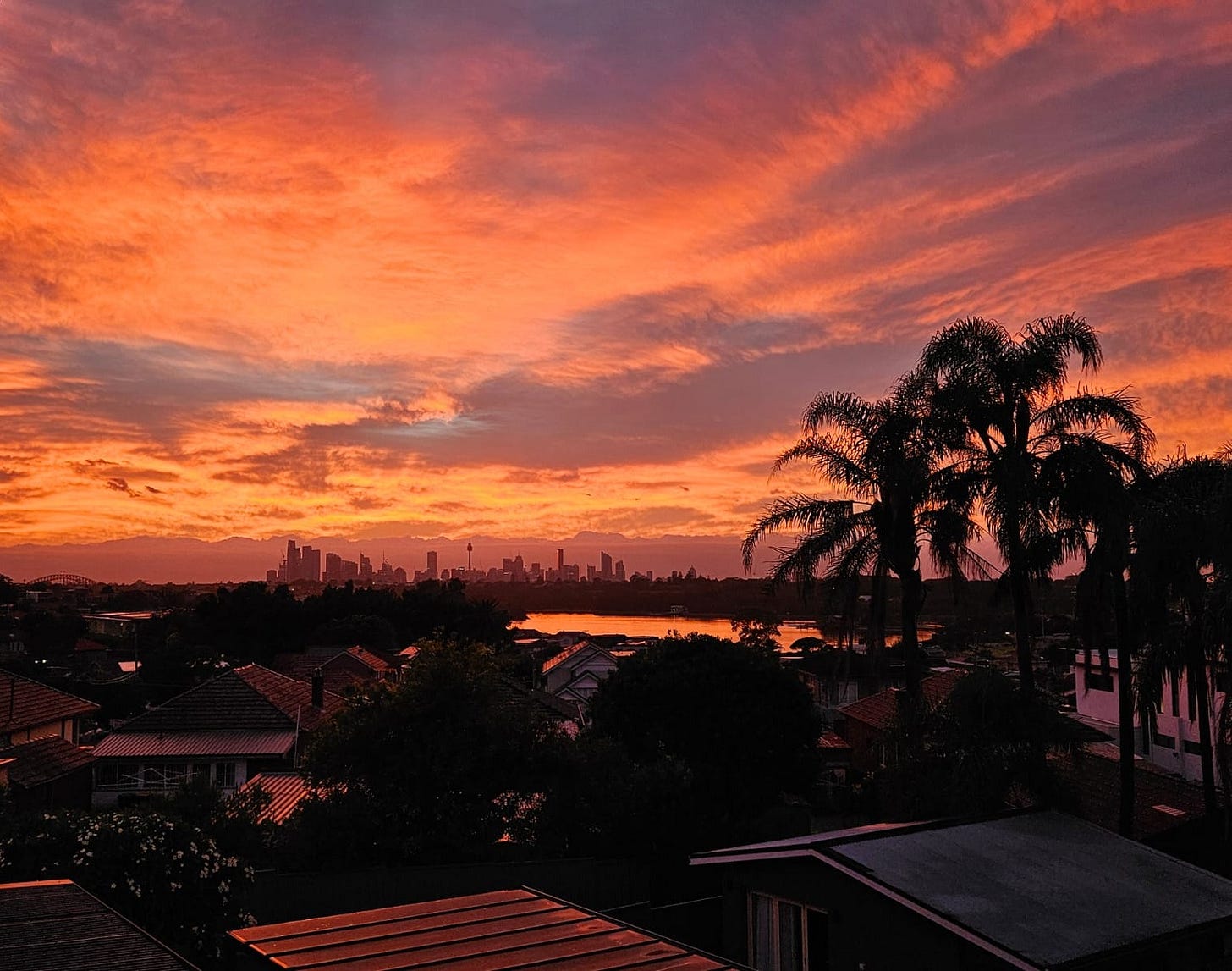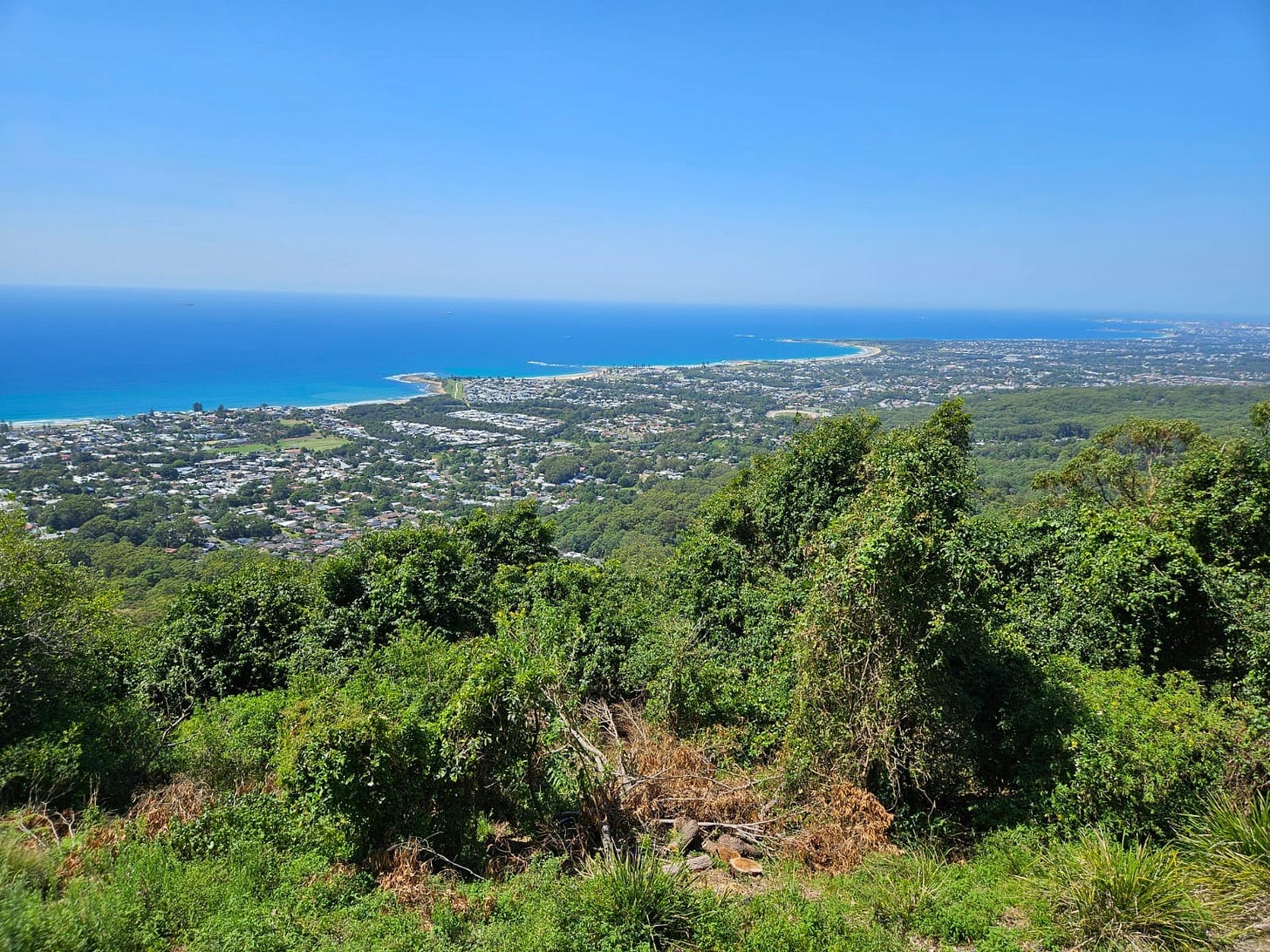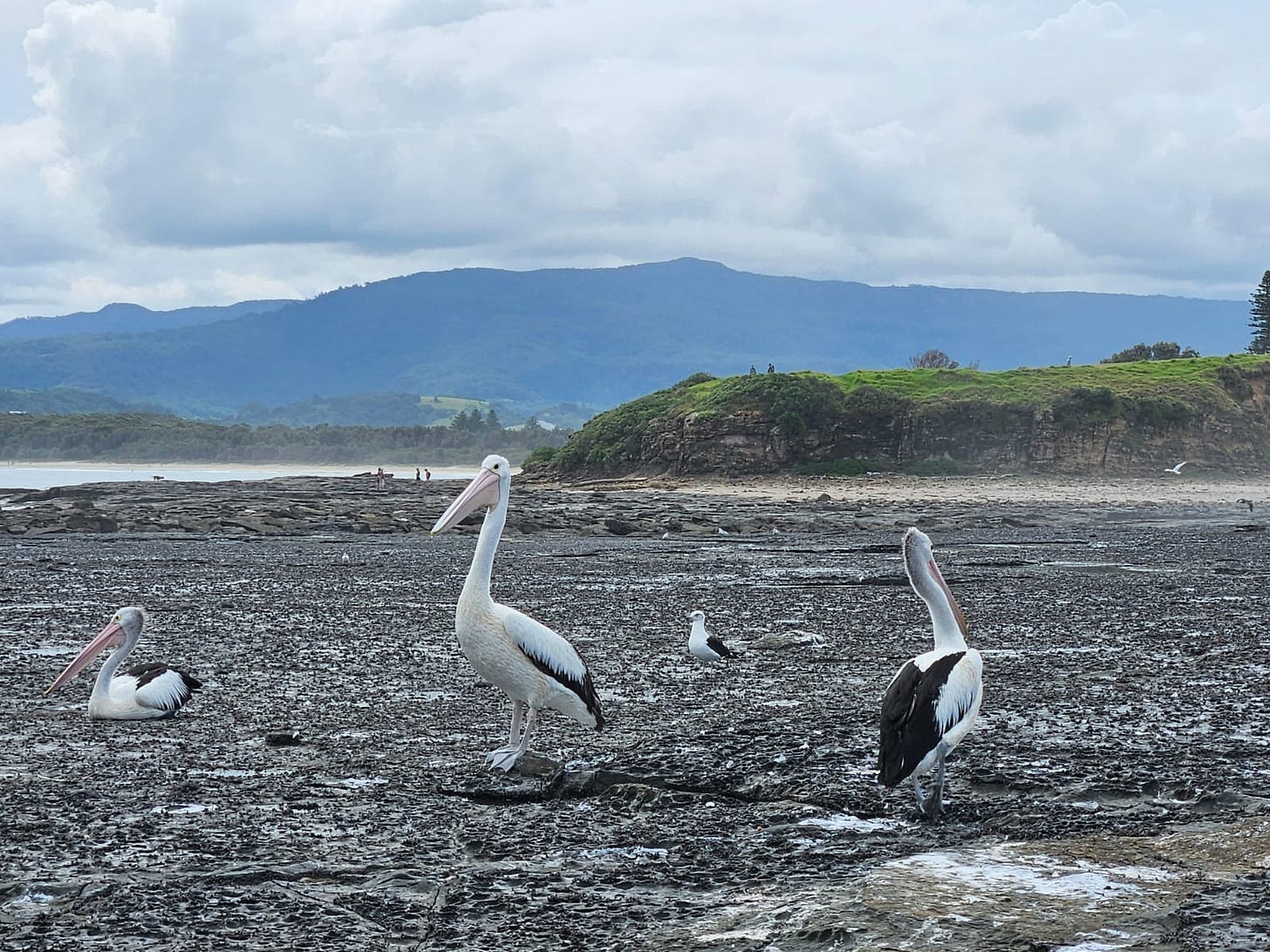Tangled Up in Blue
The sea at Gerroa, Gerringong and Currarong
I’ve often said that Australians remind me of Brits at the seaside—in fact, I think that is the secret to happiness here; it is a sunny seaside sojourn that never ends. The population of this country largely clings to the coastline, as if they had been whirled outward by some centripetal force. The famous line in the national anthem, “Our home is girt by sea,” even seems to suggest that we would be thrust outwards with such force as to end up scattered to the four winds, if the ocean didn’t hold us firmly in, keeping the bulging land cinched in as tightly as a youthful William Shatner’s on-set girdle.
The sea is omnipresent in my life here. Poseidon thrusts a fat salty thumb deep into Sydney’s Inner West. I can see a large splodge of the brackish water from our upstairs balcony, shimmering grey-blue in the morning light as I roll out my yoga mat and get the day’s first glimpse of the city skyline—even though our famous beaches are relatively far, at least in my carless state. Bondi is a long multi-bus journey away and Manly can only be reached by crossing forty-five minutes of water, down a wide snaking river and then across an ever-widening harbour—an exhilarating journey, out, out towards the sea.
And the sea is one of those magical things I keep returning to in these writings because it’s immune to the effects of hedonic depletion. No matter how often I’ve seen it before, that first glimpse of a blue expanse on the horizon is always thrilling; that first cold tickle as your bare toes meet the lacy foam edges of the water. On the dating apps—where I am currently suffering through relationship purgatory (more about this in last week’s post, which you’ll find here)—almost every man writes that he loves the sea, enjoys being by the water. For many, it’s the only thing they’ve written about themselves and I’m reminded of Ken in the Barbie movie, whose profession is simply “Beach.” But yet I think it’s probably true—almost everyone does love the sea and those who live right by it love it most of all. This is a case in which familiarity certainly does not breed contempt.
A few weekends ago, I drove around the curve of the coast with my friends William and Prue, down from Sydney to the lovely town of Gerroa. We stopped at a clifftop cafe en route and, leaning on the railings of its wrap-around veranda, gazed out at the coastline laid out before us with its familiar scalloped pattern of bays and the landmark of the Wollongong breakwater lighthouse, a pale matchstick from up here.
It might feel counterintuitive that all these beaches are so similar and yet each one is so inviting. Laid out before us from our vantage point on the cliffside, their repeating pattern was obvious: one crescent of pale sand after another, each one a strip of piping against the wrinkly tablecloth of endless blue. Yet I was excited to discover the specific curve of land, the specific stretch of ocean that would be our beach for the weekend. I knew—more or less—exactly what it would look like and yet the anticipation was sweet: like the satisfying arc of a melody, the emphatic final chords of a symphony, I knew it was coming that it would look and feel just as it always does, but that it would be no less satisfying for all that.
Gerringong possesses one of Australia’s most enchanting features: an ocean pool, where you can swim in salt water, with a wall separating you from the wilder breakers of the open ocean. We shucked off our clothes on a stone bench and I picked my way over the stony shallow end and into the water. I was immersed in one shade of blue with another overhead and, beyond the stone wall enclosing us, a shade of ever-so-slightly deeper blue encircled that: blue on blue on blue. The water was cloudy with sand and my world was slightly blurry since my spectacles had been replaced by the twin plastic ovals of goggles, but beneath me I could see a shoal of little, darting fish with the occasional larger fish gliding more serenely. Under the surface, I spotted a hairy male arm pointing downwards at an angle and followed it to an octopus, grey brown, about half the size of my head—large enough not to be mistaken for the tiny blue-ringed species (Hapalochlaena fasciata), which, a signpost by the pool warns, have been sighted there and whose venom can kill within minutes. This too is a very Australian thing: nonchalantly sharing your surroundings with deadly wildlife.
Above Gerroa beach, past the suburban houses with their manicured lawns, Parma violet agapanthus and spindly spider lily flowers and the ubiquitous Arabian jasmines lightly scenting the air, a flat headland of volcanic black rock juts out from the coastline. Under the lowering grey of the morning sky, it looked as though it could be a pockmarked, windswept basalt peninsular in Norway or Iceland—but the water that fills every notch and groove was bathtub warm. I happily tucked my dress up into my bra elastic and waded through the deeper tidal pools. Every crevice was alive with crabs that scuttled away, lightning fast, as I submerged my suntanned legs and the tail of my dress flopped into the water and ballooned out behind me: many of them glow a pale dove grey and cream against the black backdrop—they are probably ghost crabs (Ocypode cordimana). Behind me lay an ordinary coastal town but on three sides there was only the sea, foamy swirl and salty spray, and the spectacle of waves forming far out, gently rounded tubes of blue at first, heading inexorably towards land and then swelling, bursting, splattering against the headland, leaving their salty taste on my lips. A family of three pelicans inspected me from a wary distance—Mr and Mrs and their overgrown offspring, a surly teen reluctant to launch out on his own, it seemed to me. They were perfectly spaced and motionless, looking straight ahead, posing in their monochrome finery with the casual insouciance of an indie band being photographed for an album cover.
A few curves further along that same coast is the town of Currarong, strung out along the seaward side of the elegant ellipsis that is Jervis Bay. I set out from the beach there one morning and started walking, heading up that long curve. The sky was a clotted grey that threatened rain but every so often the clouds cleared to reveal a blazing sun and I stopped to slather myself with sunscreen and pull my sweat-soaked hat down tightly around my forehead to secure it against the wind.
The walk up to Culburra felt endless. I looped around one beach after another, huge semicircles of coastline, as if designed by a child practising the letter M. The sand was soft and fine at first, but as I walked, my feet grew tender and blistered from the continual friction. My fifty-five-year-old hips soon began pestering me. There was no place where the going was effortless: my choices were to scramble through loose sand, calves burning, splash through the shallow water, kicking up spray as I went, or stomp along, leaving deep indentations in the strip of saturated, sago-pudding sand an arm’s length or two from the shoreline. I chose the water, in its white-paper-doily intricacy, chilly on my toes. Overhead, squadrons of pelicans patrolled the skies.
It’s not a long walk, but it was tough and slow going and I was the only human being in sight. I considered popping my earbuds in and listening to an audiobook—a suitably maritime one like the exploits and ruminations of Jack Aubrey and Stephen Maturin (I’m currently on book 7 of the series). But I kept telling myself that I would wait until I got round that next bend before I consulted my watch or dug out my phone. I was seized by the feeling of what it must be like to be shipwrecked, to be traversing an endless series of bays alone. It gave me a tiny inkling of how large the world is, of how much further things are in reality than they appear on maps. I wasn’t exactly enjoying the experience but I felt it would be wrong to dilute it. Robinson Crusoe would not have had an iPhone, after all.
Finally, I rounded one last headland and spotted a cluster of people at the far end of the beach on the shores of an inland waterway. Sandy-nosed dogs bounded around, dads and kids kayaked through the warm, shallow water. I scrambled up a reed-filled slope and out onto a broad suburban street to find myself, finally, in Culburra. I plopped myself down in some scratchy grass and meticulously brushed every grain of sand from my feet, using the last of my water to sluice the mud from between my toes. The three-block trudge down the quiet street to a place promisingly indicated by Google maps as a café and now open felt longer than the entire previous journey.
I ordered a massive fried fish taco and a brownie—I wasn’t even very hungry, but I was determined to be a glutton because I felt I deserved a reward. But then, as I groped around in my bag, panic set in. I couldn’t find my phone. As I prepared to empty my rucksack onto a vacant table, a young guy leapt up and said, “It’s OK; I’ll pay for hers.” I must confess I wolfed down the gargantuan and delicious fried fish taco, squirting mayonnaise out of the sides of my mouth and onto my T-shirt like a savage. Afterwards, a bunch of Googling and some enquiries at the café revealed there was no bus, no Uber, no taxi service currently in operation. I was steeling myself for the long trudge home when one of the waitresses offered me a lift. As we drove back, inland, through the eucalyptus forests, I felt an overwhelming sense of wellbeing—partly because of the lovely people I had just encountered, but partly also because of what the seaside experience provides.
The shoreline is a liminal space, of course, between civilisation and nature. But it had never really been so clear to me that it’s also a liminal space between adventure and comfort. The transcendentalist poet Henry David Thoreau writes about his experiences living at one with nature in the evocatively boring book—nature is monotonous; that’s part of its charm—Walden. What I failed to realise when I first read it is just how close Walden Pond is to the city of Concorde. Thoreau lived in a cottage on his best friend’s property, less than two miles from his parents’ home. He was a hermit within easy reach of creature comforts and good company, the first hipster, with the beard of a castaway but without the castaway’s desperation and enforced solitude. Like me, as I walked along the beaches of Jervis Bay, he was playing at being shipwrecked, while always keeping one foot in sea and one on shore.
“There is no Frigate like a Book,” Emily Dickinson wrote in her curly handwriting on a sheet of paper, which she then locked in her bedroom drawer at the end of another of an endless series of days secluded in her home in Amherst. The Amherst recluse was right, of course, that we can journey to the farthest reaches of this planet—and, for sci fi fans like me, well beyond it—through reading. But in fact, for these imaginative voyages, you don’t even need a book. One of the stories in The House at Pooh Corner begins by informing us that the (still too young to be literate) “Christopher Robin had spent the morning indoors going to Africa and back.” “He had just got off the boat and was wondering what it was like outside,” A.A. Milne tells us with delicious deadpan. And even in adulthood, long after you’ve learned how to spell bisy backson, proximity to the sea invites you to see yourself as a sailor.
I feel this often in this city, whose most distinctive monument, the Sydney Opera House, is a stylised depiction of a ship, with “sails” instead of roofs. And I usually approach it on shipboard, too, on the front bench of the Parramatta River ferry, craning my neck to keep my gaze fixed on it for as long as possible, even though I’ve now seen it hundreds of times before. I know how much blue water lies between us and the rest of the world. As Geoffrey Blainey writes in his wonderful history of the place, distance—the sheer expanse of ocean—shaped Australia’s history and forged its character. Circular Quay encourages you to feel like an old salt, home at last after a long voyage, a shellback, an initiate into old mate Neptune’s mysteries, tucked away here beneath the line.
Back in 2018, a year before I turned fifty, I almost drowned. I’ve written about it here—see below—that’s what inspired the name of this blog. I’ve been wary of swimming in deep open water ever since—and at the same time, oddly attracted to it, as one often is with fears.
The Second Swim
Why have I called this Substack newsletter The Second Swim? Let me explain. The Second Swim is a reader-supported publication. To receive new posts and support my work, consider becoming a free or paid subscriber.
A couple of months ago, my boss’s husband took me snorkelling in the ocean down by Currarong. I’ve been snorkelling before, in warm, calm, tropical waters, but the Australian sea is a little more unruly. I was surprised to find myself sloshed back and forth, having to kick constantly to keep from drifting onto barnacle-covered rocks. Below us were fish large and small, many shades of brown in the murky, turbulent water—disconcertingly abundant, I learned later, an easy feast for local sharks. I felt like an astronaut, a visitor to an alien world, my mask and snorkel the helmet of a spacesuit. I kept close to my companion, as close as I could without actually colliding with him. At one point, we encountered another snorkeller, a man of similar build and I began following him instead and had to awkwardly flipper my way back round to find my companion again after I discovered my mistake, chasing after him like a disoriented child who has mistaken a stranger for her mother. When I lost sight of him completely, a little later, I headed straight for the shore and didn’t so much swim as half-stumbled, half-squirmed my way up onto the beach again.
I felt a deep satisfaction and a mild thrill. The sea entices you to be tangled up in it, even though its currents and its waves can pull you out far further than you ever planned to go. At the edge of our tame and decorous lives, it’s always there waiting. And its shallows are dotted with blue-ringed octopuses and its depths are garrisoned with great white sharks.






